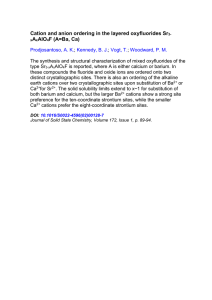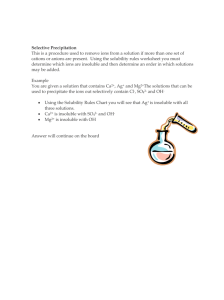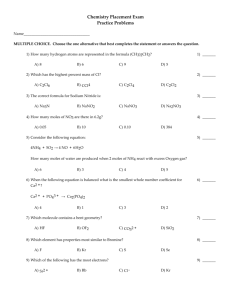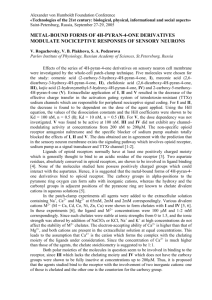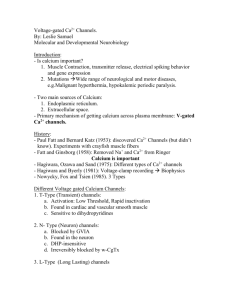Document 12694413
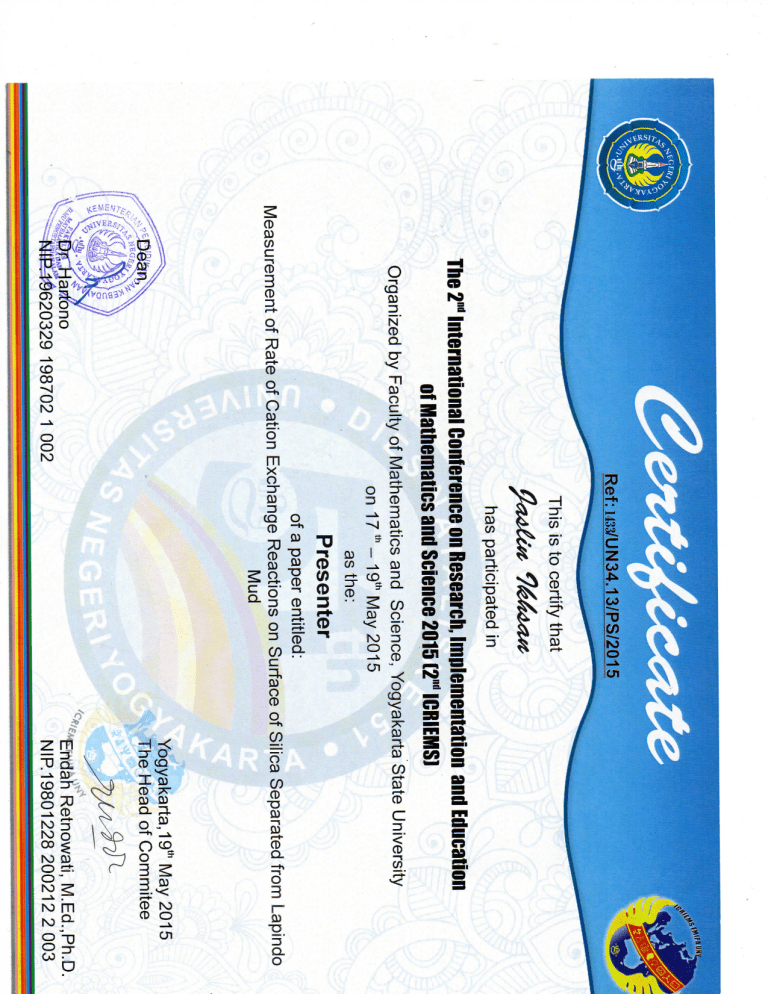
Faculty of Mathematics and Natural Sciences
Yogyakarta State University
ISBN 978-979-96880-8-8
ISBN 978-979-96880-8-8
“Recent innovative issues and findings on
the development and the education of
mathematics and science” nd
2
ICRIEMS
nd
The 2 International Conference on Research,
Implementation and Education of
Mathematics and Science
17 - 19 May 2015
Yogyakarta State University
Conference Proceedings
!
!
!
!
!
!
!
!
!
!
!
!
!
!
!
!
!
!
!
!
!
!
!
!
!
!
!
!
!
!
!
2
nd
INTERNATIONAL CONFERENCE ON RESEARCH,
IMPLEMENTATION AND EDUCATION OF
MATHEMATICS AND SCIENCE (2
nd
ICRIEMS)
Yogyakarta, 17 – 19 May 2015
ISBN 978-979-96880-8-8
!
!
Recent Innovative Issues and Findings on The Development and The Education of Mathematics and Science
Faculty of Mathematics and Science
Yogyakarta State University
!
2
nd
ICRIEMS : Recent Innovative Issues and Findings on The Development
!
!
!
!
and The Education of Mathematics and Science
!
Mathematics & Mathematics Education
!
Physics & Physics Education
!
!
Chemistry & Chemistry Education
!
Biology & Biology Education
!
!
!
!
!
!
!
!
!
!
Science Education
!
Published by:
Faculty of Mathematics and Science
Yogyakarta State University
Karangmalang, Yogyakarta 55281
Telp. (0274)550227, Fax. (0274)548203
© June 2015
Board of Reviewer
Prof. Dr. David Treagust (Curtin University)
Prof. Dr. Sopia binti Md Yassin (Universiti Pendidikan Sultan Idris)
Prof. Dr. Marsigit (Yogyakarta State University)
Prof. Dr. Mundilarto (Yogyakarta State University)
Prof. Dr. Sriatun (Yogyakarta State University)
Prof. Dr. A.K. Prodjosantoso (Yogyakarta State University)
Prof. Dr. IGP. Suryadarma (Yogyakarta State University)
Prof. Dr. Bambang Subali (Yogyakarta State University)
Dr. Ariswan (Yogyakarta State University)
Dr. Agus Maman Abadi (Yogyakarta State University)
Ouhao Chen (University of New South Wales)
Abdullah D. Dalee (Yala Rajabhat University)
Lilla Adulyasas (Yala Rajabhat University)
Proceeding of International Conference On Research, Implementation And Education
Of Mathematics And Sciences 2015, Yogyakarta State University, 17-19 May 2015
C - 7
MEASUREMENT OF RATE OF CATION EXCHANGE REACTIONS ON
SURFACE OF SILICA SEPARATED FROM LAPINDO MUD
Jaslin Ikhsan 1,2 , Siti Sulastri 1 , Erfan Priyambodo 1
1
Department of Chemistry Education, Faculty of Mathematics and Natural Sciences
Yogyakarta State University, Jl. Colombo No. 1 Yogyakarta
2 email: jikhsan@uny.ac.id, jaslinikhsan@gmail.com
Abstract
The study of cation exchange reaction is important as its potential applications, such as waste water treatment and resin. This paper was part of the research report on the desorption of cations by silica separated from Lapindo mud, and its application as slow realease fertilizer. Before investigating the desorption, adsorption of cations by the silica was conducted. This paper was to propose the reaction occuring on the surface and to measure adsorption rate of silica surface toward cations of K + and Ca 2+ .
Adsorption experiment was done as a function of contact time at constant temperature of 30 o C and pH of 7.0. The initial concentration of Ca 2+ or K + was 1.0x10
-4 M.
Adsorbed cation’s concentrations were collected by measuring free concentrations of the cations at each observed time using Atomic Absorption Spectrophotometre (AAS) for Ca 2+ and Flame Atomic Emission Spctrophotometre for K + . The data were then graphically modelled using Lagergren equations of pseudo-first order and second order kinetic. The results showed that silica bound cations of both K + and Ca 2+ by pseudo-second order reactions, from which the rate of binding of Ca 2+ was slightly higher than that of K + , as indicated by binding rate constants of Ca 2+ and K + that were calculated from the pseudo second order kinetic equation. The binding was via cation exchange reactions involving one charge from each ion, whether Ca 2+ or K + .
Key words : reaction rate, cation exchange reaction, reaction order, Lagergren equation
INTRODUCTION
The study of adsorption was conducted in this research as a part of the study on sorption process of micronutrient cations and anions by silica that was separated from Lapindo mud samples taken from East Java Indonesia. The adsorption experiments were conducted to determine the times and concentration that were optimum for the systems. By doing the adsorption experiments of micronutrient cations of Ca 2+ and K + on silica, exact time needed for interaction process and the proper concentration on the systems can be predicted, from which it helps to complete the desorption experiments for further objectives of the research on desorption kinetics of micronutrients from silica of Lapindo mud. The desorption experiments is conducted to explain the time dependence of micronutrient release from silica synthesized as cation and anion exchange sorbents. Slow release of the desorption experiments provides information of the potency of mud to be used as slow release fertilizer. This preliminary report on the adsorption was to provide suitable condition to prepare the desorption experiments.
Chemical kinetics is the study of time dependence of the change in concentration of
C-55
Jaslin Ikhsan et al. / Measurement of Rate …. ISBN. 978-979-96880-8-8 reactants and products. It tells us how quickly the reaction will proceed by measuring the decrease of reactants concentration or the increase of product concentration. On the liquid – solid phase systems as observed in this study, the concentration of solid was not known exactly. The measurement of the decrease of solid sorbent concentration of silica was from the amount of adsorbate Ca 2+ or K + bound by the silica, from which the reaction mechanism may be proposed.
Few understanding investigations and reviews have been done on chemical kinetics of adsorption reaction on liquid – solid phase systems (Ho and McKay 1998, Ho 2004, Ho 2006). The model that has been widely used to describe chemical kinetics was Lagergren Pseudo First Order or
Second Order Kinetics equation.
This paper was to measure adsorption rate of silica surface toward cations of K + and Ca 2+ via cation exchange reactions using the Lagergren equations. The reactions that may occur on the surface was explained at first before explaining the rate of the surface reactions.
RESEARCH METHOD
The subject of research was silica from Lapindo mud and cations, whereas the object of research was reaction rate of interaction between Ca 2+ or K + cations and silica. The independent variables were cation charges and contact times, and the dependent variable was the decrease of concentration of the cations due to silica adsorption.
Data were collected by kinetic adsorption experiments. The experiment procedure was adopted from Ikhsan et al.
(2005). Three (3) grams of silica separated from Lapindo mud was dissolved into 300 mL of 0.0001, 0.0005, and 0,001 M cations of Ca 2+ or K + , and pH was maintained constant at pH 7. The suspension was magnetic-stirred for 5 minutes, and a sample was taken, centrifuged, and the filtrate was measured for free concentrations of Ca 2+ or K + . The rest suspension was kept being stirred for longer contact time, 30 minutes, and again a sample was taken, centrifuged, and measured for free concentration of the cations. This experiment was repeatedly conducted until the contact time reached 3 days. The concentrations of free Ca 2+ in solution were measured using Atomic Absorption Spectrophotometre and K + using Flame Atomic
Emission Spectrophotometre. The difference of measured cation concentration from the initial ones, showed the amount of the cations bound by silica.
The data obtained from the experiments were analyzed using Lagergren Pseudo First
Order or Second Order Kinetics equation for reaction orders.
Results and Discussion
The Adsorption of Ca
2+
and K
+
Both Cations Ca 2+ and K + were adsorbed by silica (SiO
2
) from Lapindo mud in significant amount, 95% of Ca 2+ and 62% of K + during short time in 5 – 10 minutes (Figure 1).
Figure 1 and 2 showed that the equilibrium time needed to form the surface complex was about 3 hours. After 3 hours, the cations adsorbed by surface were constant, despite the trend of concentration decrease from 0 min to 10 minutes was few (Figure 2). The greatest tendency of the decrease was in the case of 0.0005 M K + cation adsorption on which it was initially adsorbed in the concentration of 0.0022 M/g SiO
2
become 0.0017 M/g silica after 3 hours contact.
C-56
Proceeding of International Conference On Research, Implementation And Education
Of Mathematics And Sciences 2015, Yogyakarta State University, 17-19 May 2015
100
80
60
40
20
0
[K] = 0,0001 M
[K] = 0.0005 M
[Ca] = 0,0001 M
[Ca] = 0,0005 M
[Ca] = 0,001 M
0 1 2 3 4 5 6
Time / (thousands minutes)
Figure 1. Percentage of Ca 2+ or K + adsorbed by SiO
2
at pH 7.0 at different initial concentrations of the cations.
0.0030
0.0025
0.0020
0.0015
0.0010
[K] = 0.0001 M
[K] = 0.0005 M
[Ca] = 0.0001 M
[Ca] = 0.0005 M
0.0005
0.0000
0 1 2 3 4 5 6
Time /(thousands nimutes)
Figure 2. The concentration of Ca 2+ or K + adsorbed per gram SiO
2
at pH 7.0 as a function of contact time.
Fast binding of SiO
2
to the cations indicated high affinity of the cations to the surface of
SiO
2
. It can be due to the nature of the surface as well as the cations. The surface of SiO
2
which is usually represented by SOH, with S is Surface and OH is hydroxyl groups, is negatively charged at alkaline solution (high pH) because of protonation and positively charged at acidic solution
(low pH) because of deprotonation, as shown by reactions 1 and 2 (Sposito 1984, Ikhsan et al.
2005).
At low pH: SOH + H +
⇄
SOH
2
+
At high pH: SOH + OH ¯
⇄
SO ¯
(1)
(2)
As a consequence, at low pH, cation affinity is weak because of electrostatic repulsion, but at high pH, the affinity is greater. The pH at which the surface tend to be in negative charge is indicated by the point zero charge (PZC, the pH at which the net surface charge is zero). PZC of SiO
2
was reported below pH 7.0 (Kosmulski, 2009). pH 7.0 was the pH at which the experiments were carried out. It is obvious that the cations had high affinity to the surfaces of SiO
2
at pH 7.0.
The nature of the cations also drives significant effects (Figures 1 and 2). The effects can be due to the hydrolysis of the cations, valence, hydrated radius, and charges. At higher pH values
C-57
Jaslin Ikhsan et al. / Measurement of Rate …. ISBN. 978-979-96880-8-8 the charges of cations decrease because of formation of metal-hydroxo species (Baes and Mesmer
1976). Valence is the another important factor affecting the adsorption fraction of metal on the surface. The difference percentage of adsorption of Ca 2+ and K + (Figures 1 and 2) on which Ca 2+ was adsorbed in such higher concentrations than K + during entire contact time may result from different valences of both cations. Divalent cations tend to adsorb surface of SiO
2
greater than that of monovalent because divalent ions had greater affinity for the surface of metal oxides than monovalent (Kinniburgh et al . 1976). Hydrated radii of cation was also has strong effect on reactivity of the cation, including on formation of the surface complex. Unhydrated Ca 2+ has smaller radii than unhydrated K + (Kielland, 1937, Volkov et al., 1997).
The surface sites reactivity is determined by the surface hydroxyl groups (SOH) which plays most important role in the interaction toward cation Ca 2+ or K + . The groups were deprotonated forming SO ¯ at higher pH values (reaction 2) above the PZC, and interacted to unhydrated or hydrated Ca 2+ or K + .
Despite Ca 2+ ions has two valences, but the fraction adsorbed by SOH of silica was much greater than K + (Figures 1 and 2). It means that both valence of Ca 2+ may not likely bind SO ¯ in the form of [(SO)
2
Ca], but may form [SOCa] + or SO[Ca(OH)] surface complexes (reaction 3 or
4). Therefore, it more likely that both ions (Ca 2+ and K + ) may interact the surface sites of silica in the form of species with one positive charge (reaction 3, 4, or 5). Based on the isotherm experiments on which the concentrations of Ca 2+ or K + were varied and the pH was kept constant, the reaction 4 (releasing proton) and the reactions 3 or 5 (without proton involvement) were more likely because the experiments needed very few concentrations of hydroxyl ions (OH ¯ ) to maintain the pH.
SO ¯ + Ca 2+
⇄
[SOCa] +
SO ¯ + Ca 2+ + H
2
O
⇄
[SO(Ca(OH)] + H +
SO ¯ + K +
⇄
[SO ¯ K + ]
(3)
(4)
(5)
If the reaction was via cation exchange as reported by Matthes et al.
(1999) who investigated the sorption of Cd 2+ , Cu 2+ , Pb 2+ , and Zn 2+ by bentonite and Ikhsan et al.
(2005) studying Zn 2+ adsorption on 3 types of cation-saturated montmorillonites, and if Ca 2+ ions had used both charges to bind the surface forming [(SO)
2
Ca] surface complexes, the adsorption fraction of Ca 2+ would have been fewer than that of K + because one ion of Ca 2+ would have bound 2 active groups of
SiO
2
surfaces, but each K + would held only one active group of the surface. So the formation of
[SO
2
Ca] surface complexes may not possible.
Modelling of Rate of Surface Complex Formation
The rate of reactions that were previously discussed indicated the time needed for the change of reactant and product concentrations. The rate was not related to maximum capacity of the surface binding the cations. Eventhough the adsorption fraction is higher, it does not mean that the rate of the reaction is faster. The rate of the adsorption was modeled using Lagergren equations. The data of kinetics experiment were model by use of Pseudo First Order or Second
Order Kinetic Model (Ho and McKay 1998). The model has been widely used to describe the sorption kinetic data (Sivaprakash et al.
2009, Renugadevi 2011, Krishna and Swamy 2012,
Ikhsan et. al.
2014). Ho and McKay (1998), Ho (2004, 2006) studied deeply those equations and their use at modelling. Pseudo-First Order Kinetic Model was represented by equation 6. dq t k
1
( q e
q t
) (6) dt where q e
and q t
are the capacity of SiO
2
to adsorb K + or Ca 2+ at equilibrium and time t , respectively
(mmol g -1 ), k
1
is the reaction first order constant with the unit of minute -1 . Integration the equation
6 with the boundary of t =0 sampai t =t, and q t
=0 to q t
= q t
, results in Lagergren Pseudo-first Order
Kinetic become the equation 7.
C-58
Proceeding of International Conference On Research, Implementation And Education
Of Mathematics And Sciences 2015, Yogyakarta State University, 17-19 May 2015 log( q e
q t
)
log( q e
)
k
1
2 , 303 t (7)
Modelling was done by fitting adsorption kinetic data towards the linear lines calculated by
Lagergren equations with the plots of log( q e
q t
) versus t from the equation 7. If the reaction has pseudo first order kinetic, the data willl fit well to the linear lines calculted by equation 7.
Conversely, if kinetic data does not fit to the plot, it means that the reactions are not pseudo first ordered. The kinetic data may fit to the plot from the equation of Lagergren Pseudo-Second Order
Kinetic (equation 8): dq t k
2
( q e
q t
)
2
(8) dt
The q e
and q t
are the same as those in first order kinetic with the unit of ‘ mmol g -1 ’, and k
2
is the pseudo second order constant, with the unit of g mmol -1 minutes -1 . The integration of equation 8 brings about the equations 9 and 10.
( q e
1
q t
)
1 q e
kt
(9) t
1
2
1 t (10) q t kq e q e
Plotting t/q t
versus t of equation 10 resulted in a linear line if the reactions were pseudo second ordered. Fitting the data by use of both Lagergren equations showed that the best fits were calculated by pseudo second order reactions, as depicted on Figures 3 and 4, and the parameters were listed in Table 1. It means that the reactions of surface complexes between both cations and
SiO
2
active sites tend to be pseudo-second order kinetic.
8
6 y = 2186.6x - 60389
R² = 0.9997
[Ca] = 0.0001 M
[Ca] = 0.0005 M
[Ca] = 0.001 M
4 y = 480.04x - 3406.6
R² = 1
2 y = 202.52x + 2489.3
R² = 0.9997
0
0 1 2 3 4 5 6
Time / (thousands minutes)
Figure 3. Modelling of the reaction rate of surface complex formation between Ca 2+ ions and
SiO
2
. The points represent experimental data, and the lines represent the fit calculated from
Lagegren pseudo second order kinetics.
The goodness of the fit was indicated by the correlation coefficients ( r ). The higher of the values of r or R 2 constant approaching to 1, the better of the fits are. Beside the r coefficient,
Kumar et al.
(2010) used q e
values (the capacity of SiO
2
sorbent to adsorb K + or Ca 2+ at equilibrium time) that were obtained from the fits of Lagergren pseudo second order equation as another indicator. The fits were considered good when the q e
values calculated from the Lagergren
C-59
Jaslin Ikhsan et al. / Measurement of Rate …. ISBN. 978-979-96880-8-8 pseudo seceond order equation were close to q e
from the experimental data. Table 1 showed that both R 2 and calculated q e
were very good. The deviation standard of calculated and experimental q e
are small.
20 y = 46583x - 5645.9
R² = 1
[K] = 0.0001 M
[K] = 0.0005 M
15
10
5 y = 656.03x - 8975.3
R² = 0.9992
0
0 0.5
1 1.5
2 2.5
3
Time / (Thousands minutes)
Figure 4. Modelling of the reaction rate of surface complex formation between K + ions and
SiO
2
. The legends represent experimental data points, and the lines are fits to the data calculated from Lagegren pseudo second order reactions.
Table 1. Fit parameters calculated from Lagergren Second Order Kinetics equation for the kinetic data of the adsorption of Ca 2+ or K + by silica
[Ca 2+ ] Linear equations
Pseudo 2 nd Order
R 2 Rate constant, k
2 q e
calc. q e
expt
0.0001 M
0.0005 M
0.0010 M
[K + ]
Y = 2686.6 X – 60389 0.9997
Y = 480.04 X – 3406.6 1.0000
Y = 202.52 X + 2489.3 0.9997
3.816
67.64
92.57
4.573 x 10 -4 4.740 x 10 -4
2.080 x 10 -3 2.090 x 10 -3
4.938 x 10 -3 4.800 x 10 -3
0.0005 M Y = 656.03 X – 897.5 0.9992 47.95 1.524 x 10 -3 1.530 x 10 -3
The rate constants ( k ) obtained from the experiments was various. It changed at different reactant concentrations (Table 1). Infact, the constants should not be dependent on the concentration of reactants of Ca 2+ or K + ions. The rate constant does not solely depend on temperatures or energy requirements, but also collision rate and steric factors. The collision rate constant is represented by the equation 11. k
N
Avog
d
AB
2
8 kT
AB
1 / 2
E
.
e RT
(11)
The equation 12 shows that the collision rate constant depends on the collision diameter
( d
AB
2 ) of the colliding molecules. The odd results of rate constants from the model were obtained for the ions with low initial concentrations (Table 1). From this fact, the reaction between cation and surface active sites was possibly not the same when the concentrations of cations different.
The form of cations interacting surface sites had different diameter for different concentrations.
For instance, Ca 2+ may interacted surface sites in the form of Ca 2+ or Ca(OH) + as discussed earlier at equations 3 and 4. The cations of calcium species in different densities may attack surface sites and form the surface complexes of silica with different colliding diameters. Levine (1978) stated
C-60
Proceeding of International Conference On Research, Implementation And Education
Of Mathematics And Sciences 2015, Yogyakarta State University, 17-19 May 2015 that the effects of solvent to reactions rate are from many sources. One of the sources is from the degree of solvation which affects rate constant k . Certain solvents even catalyze the reactions.
The reaction rate in solution involves ions or polar molecules which affect the electrostatic forces due to the dielectric constants. Steric factor is another important effect on the rate constant. The steric factor determines the relative orientation of colliding molecules or ions. Unfortunately, this factor cannot be calculated or predicted theoretically, but it must be determined empirically.
The ions of 0.0005 M of Ca 2+ and K + adsorption kinetics (Table 1) showed that the rate constant of Ca 2+ was higher than K + although the difference was not much. This result was consistent with the reactions of complex formation by both ions as represented by reactions 3 and
4, that involve only one charge. This may be able to be explained from the valence and the radii.
Ca 2+ as the divalent metal ions had greater affinity for the surface than K + monovalent ions (James and Healy 19972, Kinniburgh et al.
1976). Since the rate constant was affected by effective collision and energy requirement, therefore the affinity would affect the rate. Ca 2+ with higher affinity may have faster reaction rate to form the surface complexes. Kielland (1937) and Volkov et al.
(1997) publish ionic radii data which were listed in the Table 2. Since the different of the radii is only slight, so the different of the rate was also only small.
Table 2. Ionic radii of K + and Ca 2+
Unhydrated (pm)
K + Ca 2+
Hydrated (pm)
K + Ca 2+
Kielland (1937)
Volkov et al.
(1997)
160
149
140
100
300
331
600
412
The interaction of K + by the surface may be in the form of unhydrated species. The data show that Ca 2+ has smaller ionic radii than K + . This supported the ideas that divalent metal has greater affinity to monovalent one.
With smaller ionic radii, Ca 2+ would react easier and generally faster to form surface complexes than K + . At pH 7.0 above the PZC, the pH of kinetic experiment, however, the calcium species mainly are in form of Ca 2+ and Ca(OH) + that both attacking the surface sites. This is the reason that the surface complex formation needed few moles OH ¯ to maintain the pH (reaction 3 and 4). Hydrated radii of Ca 2+ are significantly higher than K + . The mixture of calcium species bound by the surface resulting in the little different of the rate constant between Ca 2+ and K + .
Conclusion and Suggestion
Conclusion
Whether Ca 2+ or K + was adsorbed by active sites of silica by exchanging the proton from hydroxyl groups of SiOH or called by cation exchange reaction having pseudo-second order. Both cations of Ca 2+ and K + were adsorbed very fast, and Ca 2+ had higher rate constant than K + .
Calcium species bound by the surface were Ca 2+ and Ca(OH) + , while K + ions may be interacted by the surface forming the complexes of [SO ¯ K + ].
Suggestion
Supporting data to confirm the surface complex species should be investigated, such as
ATR and FTIR spectroscopic data to identify the functional groups, and titration data to determine the proton exchange by the surface at experimental pH and to model the surface complexation.
Depth reviews and studies on the effects of steric factors should be carried out.
References
C-61
Jaslin Ikhsan et al. / Measurement of Rate …. ISBN. 978-979-96880-8-8
Baes, C. F., Mesmer, R.E. (1976). The Hydrolysis of Cations , John Wiley & Sons, New York.
Ho, Y.S., McKay, G. (1998). A Comparison of Chemisorption Kinetic Models Applied to Pollutant
Removal on Various Sorbents , Transactions of IchemE, 76B, 332-340.
Ho, Y.S., (2004). Citation Review of Lagergren Kinetic Rate Equation on Adsorption Reactions ,
Scientometrics, 59(1), pp. 171–177
Ho, Y.S., (2006). Review of second-order models for adsorption systems , Journal of Hazardous
Materials, B136, pp. 681–689
Ikhsan, J., Wells, J.D., Johnson, B.B., Angove, B.B
., (2005). Sorption of 3-amino-1,2,4-triazole and Zn(II) onto Montmorillonite, Clays and Clay Minerals, 53(2), 137 -146.
Ikhsan, J., Widjajanti LFX, E., Sunarto, (2014). Pengaruh Mordan Sintesis dari Limbah Kaleng
Terhadap Daya Ikat dan Laju Lepas Zat Warna Methyl Violet Oleh Serat Kain , SAINTEK,
19(I), pp. 59-74.
James, R.O., Healy, T.W., (1972). Adsorption Hydrolyzable Metal Ions at the Oxide-Water
Interface. I. Co(II) Adsorption on SiO
2
and Ti
2
O
2
as Model Systems , Journal of Colloid and
Interface Science, 40, pp. 42-52.
Kinniburgh, D.G., Jackson, M.L., Syers, J.K. (1976), Adsorption of Alkaline Earth, Transition, and Heavy Metal Cations by Hydrous Oxide Gels of Iron and Alumunium , Soil Science
Society of America Journals, 40, pp. 796-799.
Kielland, J., (1937). Effective Diameters of Unhydrated and Hydrated ions, Individual Activity
Coefficients of Ions in Aqueous Solutions , Journal of the Amican Chemical Society,. 59, pp.
1675-1678, accessed from http://www.electrobionics.org/ ionic_radii.pdf on March 26,
2015
.
Kosmulski, M., (2009). pH-dependent Surface Charging and Points of Zero Charge. IV. Update and New Approach , Journal of Colloid and Interface Science, 337, pp. 439–448.
Krishna, R. H., Swamy, A.V.V.S., (2012). Physico-Chemical Key Parameters, Langmuir and
Freundlich Isotherm and Lagergren Rate Constant Studies on The Removal of Divalent
Nickel from the Aqueous Solutions onto Powder of Calcined Brick , International Journal of
Engineering Research and Development, e -ISSN: 2278-067X, p -ISSN: 2278-800X, www.ijerd.com, 4(1), pp. 29-38.
Kumar, P. S., Vincent, C., Kirthika, K., and Kumar, K.S., (2010). Kinetics and Equilibrium Studies of Pb
2+
Ion Removal from Aqueous Solutions by Use of Nano-Silversol-Coated Activated
Carbon , Brazilian Journal of Chemical Engineering, 27(2), pp. 339 – 346.
Levine, I.N., (1978). Physical Chemistry, 1 st edition, New York: McGraw-Hill.
Matthes, W., Madsen, F.W., Kahr, G. (1999). Sorption of Heavy-Metal Cations by A1 and Zr-
Hydroxy-Intercalated and Pillared Bentonite , Clays and Clay Minerals, 47(5), pp. 617-629
.
Renugadevi, N., Sangeetha, R., Lalitha, P. (2011) .
Kinetics of the Sorption of Methylene Blue from an Industriak Dyeing Effluent onto Activated Carbon Prepared from the Fruits of Mimusops
Elengi , Archives of Applied Science Research, 3(9), 492-498.
Sivaprakash, A., Aravindhan, R., Ranghavarao, J., Nair, B.U., (2009). Kinetics and Equilibrium
Studies on the Biosorption of Hexavalent Chromium from Aqueous Solutions Using Bacillis
Subtilis Biomass , Applied and Environmental Research , 7(1), 45-57.
Sposito, G. (1984). The Surface Chemistry of Soils , Oxford: Oxford University Press, p. 174
Volkov, A. G., Paula, S., Deamer, D. W., (1997). Two Mechanisms of Permeation of Small Neutral
Molecules and Hydrated Ions Across Phospholipid Bilayers , Bioelectrochem. Bioenergetics
42, pp. 153-160, accessed from http://www.electrobionics.org/ionic_radii.pdf on March 26,
2015.
C-62
